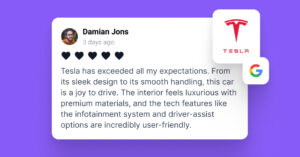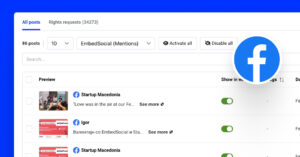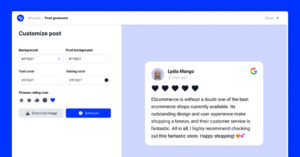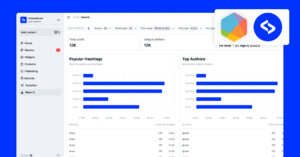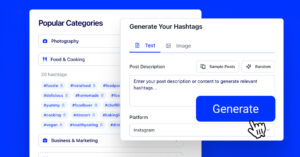Imaginez que vous repériez un sweat à capuche élégant en faisant défiler Instagram, que vous appuyiez sur "Acheter maintenant" et que vous effectuiez votre achat sans jamais quitter l'application.
Ou encore trouver le produit de soin idéal sur Facebook, cliquer sur "Acheter" et passer à la caisse en quelques clics sans quitter la plateforme.
Cette expérience transparente est la raison d'être du commerce social.
En termes simples, le commerce social apporte la l'ensemble du parcours d'achat-découverte, recherche et achat -directement sur les médias sociaux utilisées quotidiennement.
Et elle est en plein essor : les acheteurs attendent aujourd'hui des marques qu'elles les rencontrent là où ils se trouvent, que ce soit sur Instagram, Facebook, Pinterest, TikTok ou même YouTube.
Par exemple, le département de recherche de Statista a révélé qu'en 2025, les ventes réalisées par l'intermédiaire des réseaux de médias sociaux s'élevaient à près de 1,5 milliard d'euros. 18% de toutes les ventes en ligne.
C'est pourquoi j'ai décidé de définir le commerce social, d'expliquer comment fonctionne le commerce électronique social, de mettre en évidence les meilleures pratiques en matière de commerce social et de vous montrer comment tirer le meilleur parti de cette tendance croissante pour stimuler les ventes et la visibilité en ligne de votre marque.
Plongeons dans l'avenir du shopping !
Qu'est-ce que le commerce social ?
Comment fonctionne le commerce social ? C'est très simple :
Le commerce social est l'utilisation des plateformes de médias sociaux pour promouvoir, vendreet acheter des produits sans quitter la plate-forme.
Définition du "commerce social
Vous avez dû le faire vous-même, n'est-ce pas ? Au lieu de cliquer sur un lien vers un autre site web, vous avez acheté le produit que vous aviez découvert sur la même plateforme sociale.
Les meilleures plateformes pour une telle action sont Instagram, Facebook, TikTok et Pinterest, car elles intègrent une expérience de marché transparente.
L'objectif du commerce social est simple : rendre les achats plus rapides, plus faciles et plus naturels pour les utilisateurs qui s'engagent déjà avec les marques dans leurs espaces numériques préférés.
Si l'idée de combiner les médias sociaux et le shopping n'est pas nouvelle, la véritable explosion du commerce électronique social s'est produite ces dernières années, lorsque les plateformes ont ajouté de nouvelles fonctionnalités telles que paiement in-app, étiquettes de produits, achats en directet vidéos à visionner.
En bref, le commerce social est le lieu du shopping social, la nouvelle génération d'achats en ligne, au même titre que les likes, les commentaires et les partages.
Commerce social et commerce électronique
Tandis que Commerce électronique se produit sur des sites web autonomes tels qu'Amazon ou des boutiques Shopify, commerce social maintient l'ensemble de l'expérience d'achat dans les médias sociaux.
Dans le commerce électronique, les acheteurs quittent une plateforme pour se rendre sur un site web externe. Dans le commerce social, ils découvrent, parcourent et achètent sans jamais quitter Instagram, Facebook, TikTok ou Pinterest.
Voici un petit tableau des différences :
| Commerce social | Commerce électronique |
| L'ensemble de l'expérience d'achat se déroule dans des applications de médias sociaux comme Instagram, Facebook, TikTok et Pinterest. | L'expérience d'achat se déroule sur des sites web externes tels qu'Amazon, des magasins Shopify ou des boutiques en ligne appartenant à la marque. |
| Les acheteurs naviguent, font des recherches et achètent sans quitter la plateforme sociale. | Les acheteurs sont dirigés depuis les médias sociaux ou les publicités vers un site distinct pour effectuer leurs achats. |
| L'accent est mis sur des achats rapides et transparents au sein d'un réseau de distribution. flux de médias sociaux. | Ils se concentrent sur la présentation détaillée des produits, sur la narration de la marque et sur des catalogues de produits souvent plus volumineux. |
| Les fonctionnalités sociales telles que les likes, les partages, les commentaires et le marketing d'influence en sont la clé. | Alimenté par le trafic des moteurs de recherche, les annonces payantes, le marketing par courrier électronique et les visites directes. |
Commerce social et marketing des médias sociaux
Le commerce social, quant à lui, consiste à vendre des produits directement sur les canaux des médias sociaux, marketing des médias sociaux génère du trafic de référence à partir de les médias sociaux vers un site web ou un magasin en ligne. Ainsi, toute l'expérience se déroule en dehors du site social.
Avantages du commerce social pour votre entreprise
Le commerce social est une stratégie puissante pour fidéliser et développer votre marque là où les clients potentiels passent déjà leur temps pour plusieurs raisons :
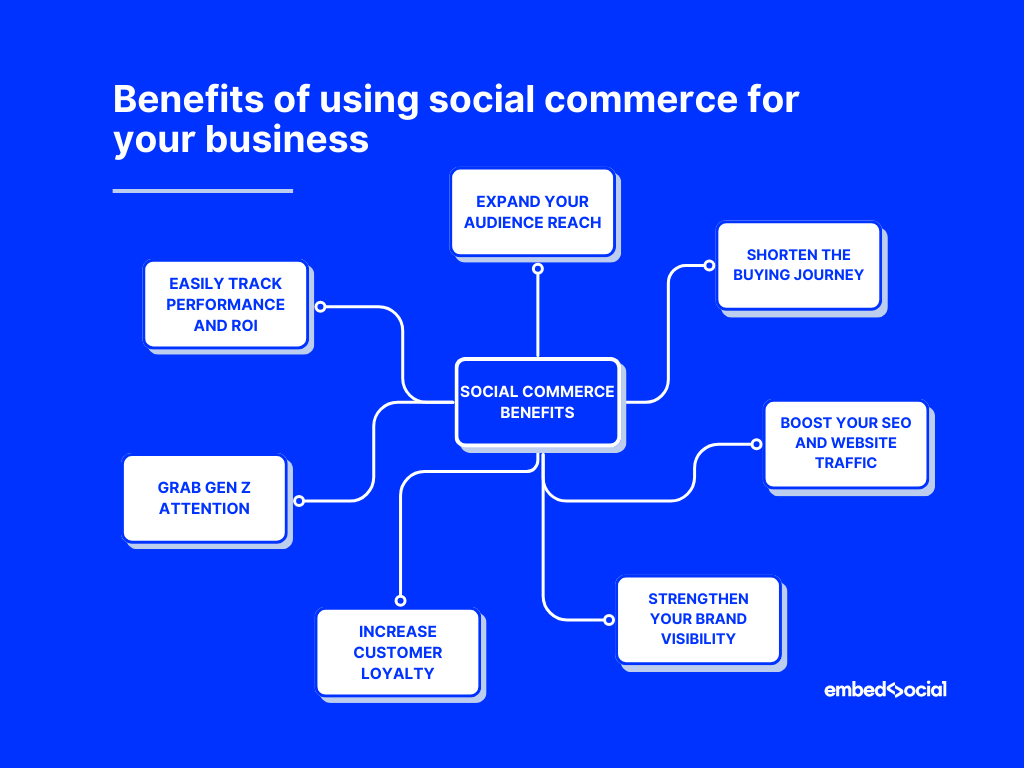
- Élargissez votre audience sans effort-Les plateformes sociales attirent des milliards d'utilisateurs chaque jour, exposant ainsi vos produits à un public cible plus large et très engagé ;
- Raccourcir le parcours d'achat-Les clients peuvent découvrir, rechercher et acheter des produits sans quitter leurs applications sociales préférées, ce qui accélère les conversions ;
- Améliorez votre référencement et le trafic de votre site web-L'augmentation de l'engagement et du partage social peut accroître le trafic vers votre site web et améliorer votre classement dans les moteurs de recherche ;
- Renforcer la visibilité de votre marque-La visibilité constante des produits à travers les flux, les histoires et les vidéos renforce la reconnaissance de la marque et permet d'établir des liens plus étroits avec les clients ;
- Accroître la fidélité et la rétention des clients-l'interaction directe sur les canaux sociaux favorise des relations plus fortes, encourageant les achats répétés et la loyauté à long terme ;
- Exploiter les habitudes d'achat de la génération Z et des milléniaux-les jeunes préfèrent acheter via les médias sociaux, ce qui rend le commerce social essentiel pour assurer la pérennité de votre marque ;
- Suivre facilement les performances et le retour sur investissement-Les analyses intégrées à la plateforme facilitent la mesure des impressions, de l'engagement, des clics et des ventes, le tout en un seul endroit.
Comme vous pouvez le constater, l'exploitation du commerce social donne à votre marque l'avantage dont elle a besoin pour transformer le défilement quotidien en une véritable croissance commerciale.
6 meilleures plateformes de commerce social pour votre marque
Presque tous les réseaux sociaux ont aujourd'hui intégré une fonctionnalité de commerce social, car c'est ainsi que fonctionne le commerce social.
C'est pourquoi, en consultant leur pays d'origine outils de commerce social est la clé de la connexion avec les clients et de l'augmentation de vos ventes sur les médias sociaux.
Voici donc un examen plus approfondi de la meilleures plateformes de commerce social:
Instagram Shopping
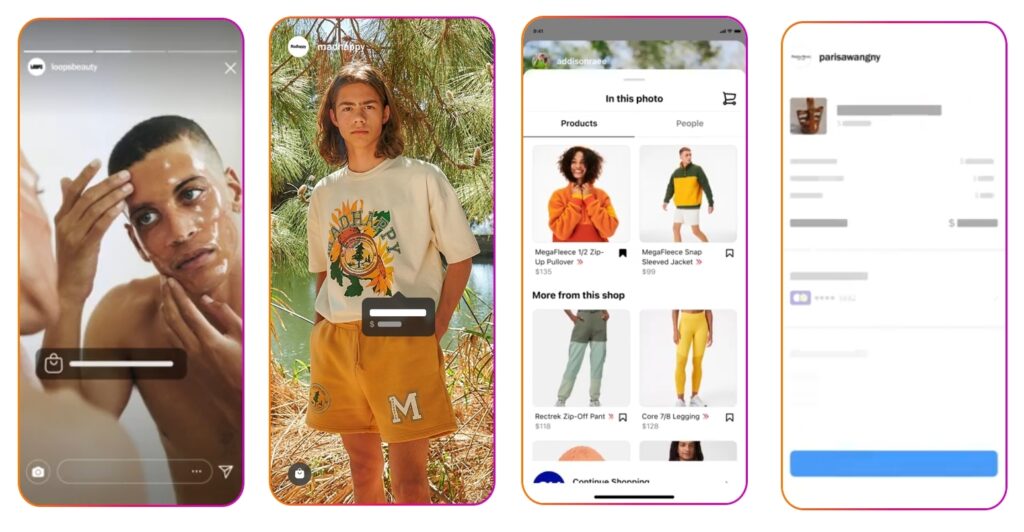
Instagram Shopping permet aux marques de créer facilement une vitrine à l'intérieur même de l'application Instagram. Ainsi, les utilisateurs peuvent découvrir des produits, parcourir des collections et effectuer des achats sur la plateforme, ce qui fait d'Instagram l'un des acteurs les plus solides du commerce social.
Voici les principales façons de vendre des produits sur Instagram :
- Achats dans l'alimentation-Marquez les produits directement dans vos photos ou dans vos publications en carrousel afin que les utilisateurs des médias sociaux puissent cliquer dessus et voir les détails instantanément ;
- Le shopping dans les histoires-ajoutez des autocollants de produits à vos Stories Instagram, ce qui permet aux followers de faire des achats directement à partir du contenu de votre Story ;
- Faire du shopping à Explore-Obtenez que vos posts shoppables soient présentés dans l'onglet Explore, où les utilisateurs recherchent activement de nouvelles marques et de nouveaux produits ;
- Les achats en bobines-étiqueter les produits dans votre Bobines Instagram pour associer la découverte des produits au divertissement et accélérer les achats ;
- Événements d'achat en direct-organiser des émissions en direct au cours desquelles vous présentez des produits et permettez aux téléspectateurs d'acheter des articles en temps réel pendant la diffusion de l'émission ;
- Pages détaillées sur les produits Instagram (PDP)-Créez des pages de produits dédiées sur Instagram qui contiennent des informations pertinentes sur les produits, les prix et les liens de paiement.
Pour ouvrir un Boutique Instagram pour votre marque, répondez aux exigences suivantes :
- Disposer d'un Instagram Business ou un compte Créateur connecté à une page Facebook ;
- Vendre des produits physiques conformes aux politiques commerciales d'Instagram ;
- Opérer dans un pays où Instagram Shopping est pris en charge ;
- Créez un catalogue de produits via Facebook Commerce Manager ;
- Posséder un domaine à partir duquel vous avez l'intention de vendre et qui répertorie vos produits.
Une fois approuvé, vous pouvez commencer à étiqueter des produits dans votre contenu et créer une expérience de commerce social complète au sein de votre profil Instagram.
Pour en savoir plus sur toutes les options d'achat sur Instagram et sur la façon dont vous pouvez commencer, consultez la page guide étape par étape que nous avons créée pour vous.
Consultez également notre article de blog "Nouvelles fonctionnalités d'Instagram que tout marketeur doit connaître : édition 2025"pour en savoir plus sur les prochaines Mises à jour Instagram.
Boutiques Facebook
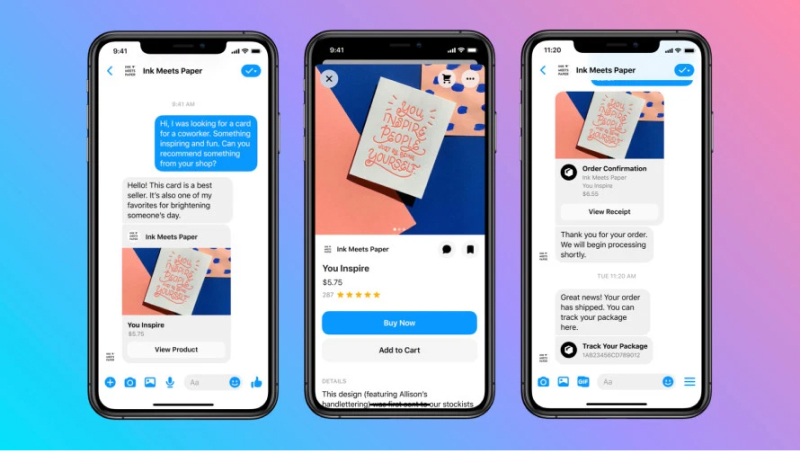
Boutiques Facebook permettent aux entreprises de créer facilement une vitrine en ligne directement dans Facebook, créant ainsi une expérience d'achat mobile qui semble naturelle aux utilisateurs.
Les marques peuvent alors présenter leurs produits, mettre en avant leurs collections et permettre aux clients potentiels de naviguer, de sauvegarder et même d'acheter sans quitter l'application.
La mise en place d'une boutique Facebook est simple. Voici ce dont vous aurez besoin :
- Avoir une page d'entreprise Facebook ;
- Créer un Facebook Commerce Manager compte ;
- Téléchargez un catalogue de produits existant ou créez-en un à partir de zéro ;
- Se conformer aux conditions d'éligibilité commerciale de Facebook ;
- Connectez votre boutique à un partenaire de commerce électronique si vous souhaitez activer le paiement sur Facebook (disponible dans certains pays).
Une fois que votre boutique est en ligne, les clients peuvent vous envoyer des messages directement via Messenger, Instagram Direct ou WhatsApp, et vous pouvez établir des relations plus solides et une plus grande confiance.
De plus, si vous avez déjà vendre sur InstagramAvec Commerce Manager, vous pouvez gérer vos boutiques Facebook et Instagram à partir d'un point central.
Avec des millions d'utilisateurs qui s'engagent chaque jour avec des marques, les boutiques Facebook offrent un moyen transparent de transformer la découverte de produits en conversions, directement dans l'application.
Pinterest Shopping
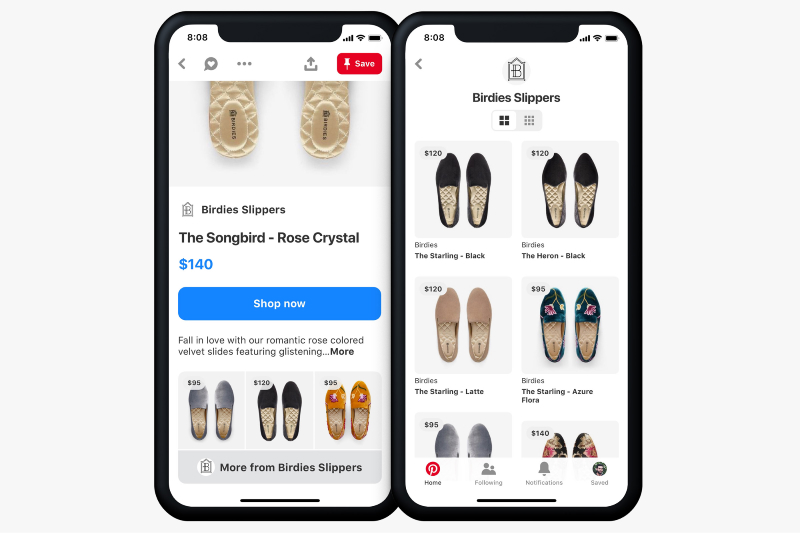
Bien que Pinterest ne dispose pas d'une vitrine traditionnelle comme Instagram ou Facebook, il est devenu une puissante plateforme de commerce social grâce à ses fonctions d'achat uniques - les utilisateurs découvrent des idées et des produits, ce qui en fait un endroit idéal pour entrer en contact avec les acheteurs.
Les entreprises peuvent mettre en place Pinterest Shopping en téléchargeant un catalogue de produits et en créant Épingles à produits qui affichent en temps réel les prix, la disponibilité et les descriptions des produits. De plus, elles se mettent à jour au fur et à mesure que votre inventaire évolue, ce qui permet aux utilisateurs de toujours disposer des informations les plus récentes.
Pinterest propose également des fonctionnalités telles que les annonces d'achat, les épingles "Shop the Look" et l'onglet Pinterest Shop, qui permettent aux utilisateurs d'explorer et d'acheter facilement les produits qu'ils trouvent.
Pour commencer à utiliser Pinterest Shopping, vous devez :
- Créez un compte Pinterest Business ;
- Réclamez votre site web sur Pinterest ;
- Téléchargez votre catalogue de produits via Pinterest Catalogs ;
- Veillez à ce que vos produits soient conformes aux directives de Pinterest à l'intention des marchands ;
- Activez les épingles à produits et organisez vos produits en collections.
Avec environ 9 utilisateurs de Pinterest sur 10 déclarant que la plateforme influence leurs décisions d'achat, Pinterest offre une opportunité incroyable de transformer l'inspiration en ventes réelles - en particulier pour les marques dans les catégories de la mode, de la décoration intérieure, de la beauté et de l'art de vivre.
Pour en savoir plus sur la manière dont vous pouvez améliorer votre stratégie marketing en utilisant Pinterest, consultez notre rubrique Guide des épingles à histoires sur Pinterest.
Twitter Shops
Bien que X (Twitter) soit plus connu pour ses conversations en temps réel que pour ses achats, il a introduit plusieurs fonctions de commerce social pour aider les marques à augmenter leurs ventes.
Twitter Shops permettent aux entreprises de créer une section dédiée aux achats sur leur profil, où elles peuvent présenter jusqu'à 50 produits.
Lorsque les utilisateurs cliquent sur "Voir la boutique", ils peuvent parcourir la collection et cliquer pour acheter des produits directement sur le site web de la marque.
En plus des boutiques complètes, Twitter propose également des vitrines de boutiques, plus petites, affichées en haut du profil d'une entreprise, ce qui permet aux utilisateurs mobiles de découvrir et de parcourir plus facilement les produits présentés sans avoir à faire défiler la page trop loin.
Pour mettre en place des achats sur Twitter, vous aurez besoin de :
- Un compte professionnel Twitter ;
- Conformité avec les politiques marchandes de Twitter ;
- Une entreprise basée aux États-Unis (pour l'instant, les boutiques Twitter sont principalement disponibles aux États-Unis) ;
- Un catalogue de produits téléchargé et connecté par l'intermédiaire de la configuration commerciale de Twitter.
X (Twitter) offre aux marques un moyen puissant de combiner l'engagement en temps réel et la découverte de produits, en particulier lors d'événements, de lancements de produits et de campagnes de hashtags.
Alors que X (Twitter) continue d'investir dans des outils de commerce, les premiers utilisateurs ont la possibilité de se démarquer et d'établir des relations plus étroites avec les clients directement à travers leur profil.
Boutique TikTok
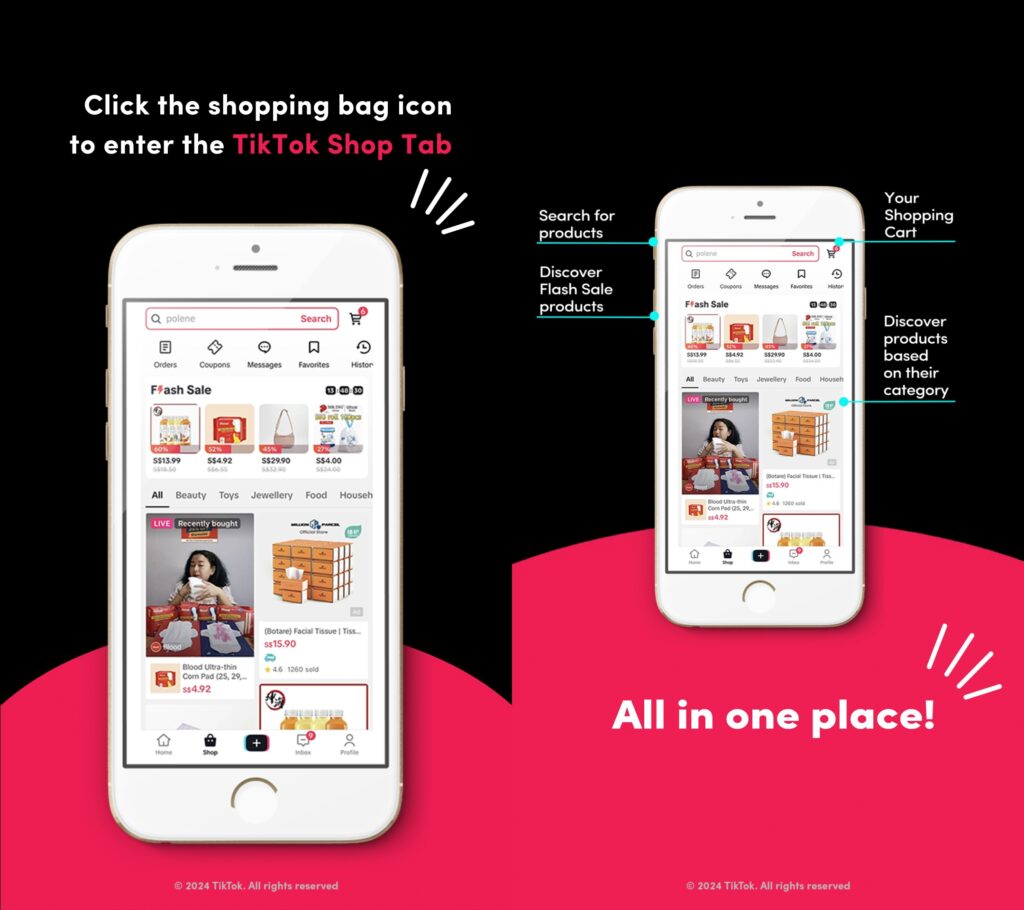
TikTok Shop a rapidement positionné TikTok en tant que leader du commerce social, en combinant le divertissement viral avec des possibilités d'achat instantané.
Les marques peuvent étiqueter des produits directement dans leurs vidéos, livestreams et collaborations avec des créateurs, ce qui permet aux utilisateurs de découvrir et d'acheter sans jamais quitter l'application.
Au-delà du marquage standard des produits, TikTok propose des événements d'achat en direct, des annonces shoppables et des présentations de produits dans le flux qui s'intègrent parfaitement à l'expérience de l'utilisateur, ce qui permet de transformer facilement des moments viraux en conversions en temps réel.
Pour commencer à vendre sur TikTok Shop, il vous faut
- Un compte professionnel TikTok ;
- Une entreprise enregistrée qui répond aux conditions de vente de TikTok ;
- Un compte TikTok Shop approuvé (disponible dans certains pays) ;
- Un catalogue de produits connecté ou des listes téléchargées par l'intermédiaire du Centre des vendeurs de TikTok.
Grâce à son algorithme unique et à son approche axée sur le contenu, TikTok permet même aux petites marques d'atteindre des audiences massives, de créer un buzz rapidement et de susciter des achats impulsifs dans un format très engageant.
YouTube Shopping
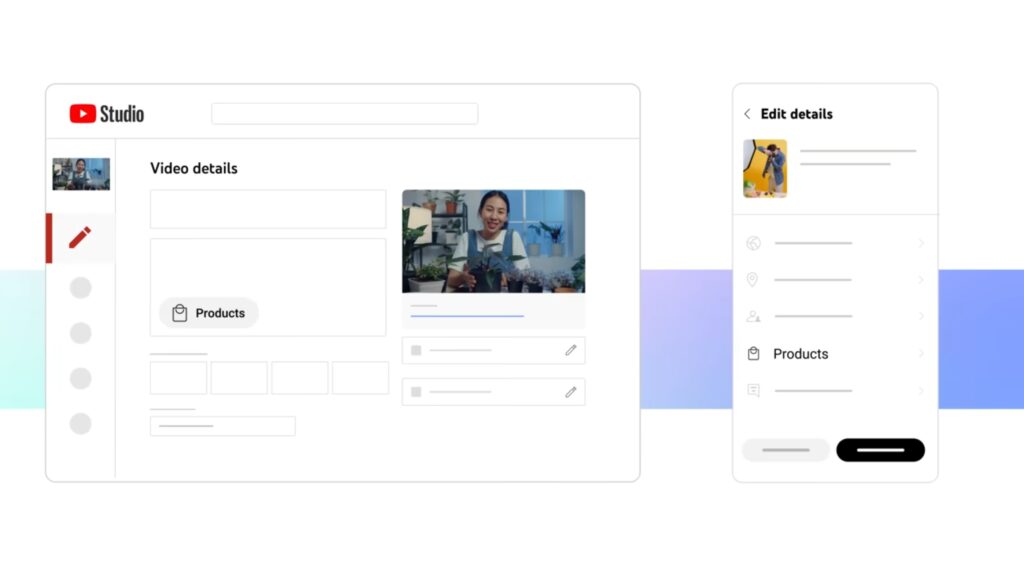
YouTube Shopping permet aux marques et aux créateurs de transformer leur contenu vidéo en une expérience d'achat complète. Le marquage des produits étant désormais disponible dans les vidéos ordinaires, les courts métrages, les livestreams et même dans l'onglet boutique d'une chaîne, YouTube est devenu une puissante plateforme de commerce social pour la découverte et l'achat de produits.
Les spectateurs peuvent explorer les produits présentés dans une vidéo, consulter des informations détaillées sans quitter YouTube et effectuer leurs achats en toute transparence, soit par l'intermédiaire de boutiques connectées comme Shopify, soit par des liens externes.
Pour activer YouTube Shopping pour votre marque, vous aurez besoin de :
- Une chaîne éligible au programme de partenariat YouTube ;
- Respect des politiques de monétisation et de commerce de YouTube ;
- Une plateforme de commerce électronique connectée (comme Shopify) ou un compte Google Merchant Center ;
- Listes de produits approuvées et synchronisées avec les fonctions Shopping de YouTube.
Avec des millions de spectateurs qui se tournent vers YouTube pour obtenir des avis sur des produits, des tutoriels et des présentations, la vente directe par le biais de la vidéo constitue un moyen efficace d'atteindre des publics très intéressés et de combler le fossé qui sépare l'inspiration de l'achat.
5 bonnes pratiques en matière de commerce social
Pour que votre stratégie de commerce social prenne le meilleur départ, voici quelques bonnes pratiques que vous pouvez mettre en œuvre dès maintenant :
1. Promouvoir vos produits à venir
Le détaillant de vêtements Zara offre un bon exemple de la manière d'augmenter la demande pour vos produits avant même qu'ils n'arrivent sur le marché, puisqu'elle en fait la promotion à l'avance :

2. Fusionnez votre commerce social avec votre plateforme de commerce électronique
Si vous gérez une plateforme de commerce électronique, vous pouvez mettre en place une stratégie omnicanale par son intermédiaire, car vous pouvez y connecter tous vos canaux de vente, y compris vos médias sociaux.
3. Vendre avant tout des produits à bas prix
Les acheteurs en ligne se rendent sur les médias sociaux pour se divertir, sans penser à dépenser pour des produits coûteux. Il est donc plus probable que vous fassiez une vente si vous vous concentrez sur des produits bon marché. Pensez-y : ils n'achèteront pas un sac de $500 sur un coup de tête via un site web de Annonce d'une histoire sur Instagram.
4. Collecter les adresses électroniques des utilisateurs
Il est plus facile de faire de la vente incitative après avoir vendu un produit moins cher. Une fois que vous avez réalisé cette première vente, récupérez son adresse électronique pour l'utiliser dans le cadre d'une stratégie de marketing par courrier électronique. Vous devez entretenir la relation et instaurer un climat de confiance avant de pouvoir demander une vente importante, n'est-ce pas ?
5. Stimuler et générer une preuve sociale
Preuve sociale est aujourd'hui un élément essentiel de toute stratégie de marketing numérique, et vous pouvez facilement en obtenir par le biais d'une plate-forme de surveillance des médias sociaux comme EmbedSocial. Il vous donne toutes les informations dont vous avez besoin pour trouver des conversations et des commentaires autour de votre marque sur les médias sociaux.
Faites-en plus avec le commerce social : Utilisez EmbedSocial !
Tirer parti du commerce social, c'est créer des expériences d'achat fluides et stimulantes sur tous les canaux. C'est là que le EmbedSocial arrive :
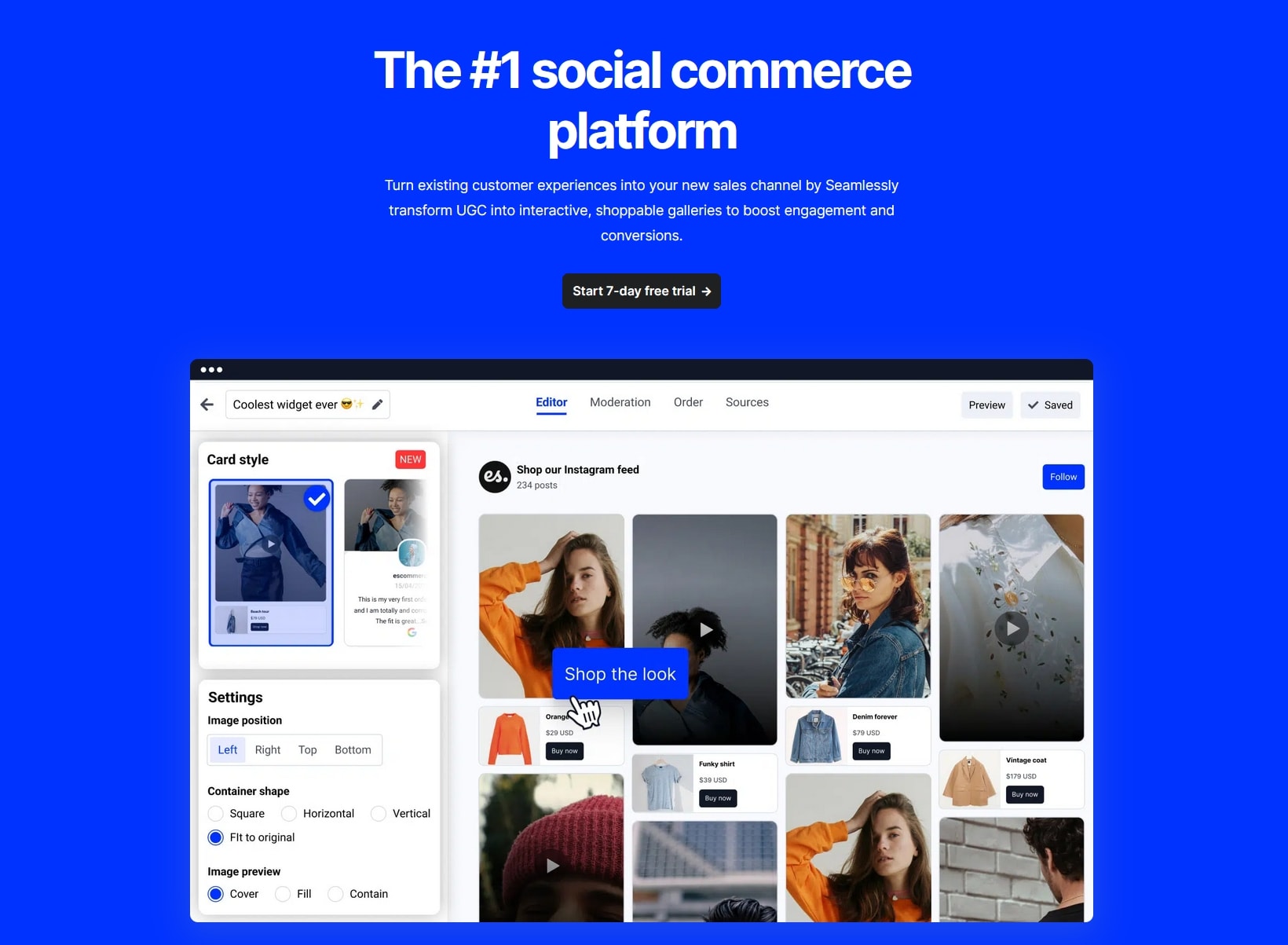
Nous vous aidons à transformer vos flux de médias sociaux en 'Shop My Feedqui transforment l'engagement en ventes réelles. Voici comment EmbedSocial vous aide à y parvenir :
- Widgets pour les médias sociaux-intégrer votre InstagramVous pouvez afficher sur votre site web les flux de Facebook, TikTok ou YouTube avec des CTA cliquables qui incitent à l'achat ;
- Écoute des médias sociaux-suivre les mentions, les hashtags et les contenu généré par l'utilisateur pour découvrir et mettre en valeur les messages authentiques des clients ;
- Galeries d'achat personnalisables-conçoit de magnifiques affichages de marque qui correspondent au style de votre site web et qui augmentent les conversions ;
- Étiquetage direct des produits-lien vers des produits spécifiques messages sur les médias sociaux pour une expérience de navigation et de paiement transparente grâce à un système de paiement en ligne. Widget UGC pour les achats;
- Analyses et informations sur les performances-mesurer les clics, les conversions et l'engagement sur l'ensemble de vos flux sociaux intégrés afin d'optimiser les résultats.
Que vous souhaitiez favoriser la découverte d'un produit, établir une relation de confiance avec les consommateurs, vous pouvez vous appuyer sur les informations fournies par le site web. contenu généré par l'utilisateurEmbedSocial vous offre les outils nécessaires pour rendre le commerce social efficace et sans effort. Alors, pourquoi ne pas créer dès aujourd'hui ce canal de vente performant ?
Voici un aperçu de ce que vous obtiendrez : un flux d'UGC commercialisable en direct :
Remarque : Les widgets d'EmbedSocial sont entièrement personnalisables et vous pouvez tout changer, du modèle aux couleurs individuelles, en passant par les boutons, les bannières, etc. Vous pouvez même utiliser un code CSS personnalisé pour obtenir l'aspect qui convient le mieux à la conception de votre site web.
Conclusion : Le commerce social est là où se trouvent vos clients !
Si vos clients font défiler la page, c'est qu'ils font des achats en ligne.
C'est là toute la magie du commerce social : rencontrer les gens là où ils passent déjà du temps et transformer l'engagement en ventes de commerce social sans effort.
En adoptant des plateformes comme Instagram, Facebook, Pinterest et TikTok, votre marque peut transformer la découverte de produits en conversions instantanées.
Avec la bonne stratégie et les bons outils, votre entreprise peut fournir un service d'information en ligne fluide et natif. Shopping sur Instagram une expérience personnelle, rapide et amusante.
Ce processus fonctionne parfaitement sur toutes les autres plateformes de médias sociaux dotées de fonctions de commerce social, telles que TikTok, Facebook, Pinterest, YouTube et bien d'autres encore.
Que vous soyez débutant ou prêt à passer à l'échelle supérieure, c'est le moment idéal pour exploiter la puissance des tendances du commerce social et commencer à vendre.
Vous voulez améliorer votre jeu de commerce social ? Commencez par ajouter un Widget UGC pour les achats à vos sites de commerce social avec EmbedSocial. 👈
L'agrégateur de médias sociaux #1
Essayez EmbedFeed et intégrez des flux Instagram, Facebook, Youtube ou TikTok sur n'importe quel site web, comme un PRO.
7 jours essai gratuit - Installation facile - Annulation à tout moment
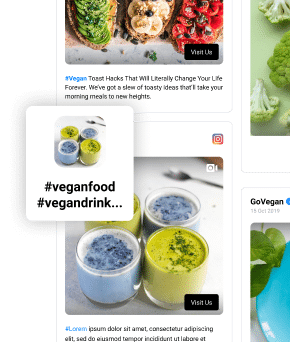
FAQ sur le commerce social
Que signifie le commerce social ?
Le commerce social consiste à utiliser les sites de médias sociaux pour vendre des produits directement aux consommateurs sans les rediriger vers un site web externe. Il combine donc le shopping et l'engagement social, ce qui permet aux utilisateurs d'acheter facilement des produits via des applications.
Comment fonctionne le commerce social ?
Le commerce social consiste à transformer le contenu des médias sociaux en opportunités d'achat. Les marques présentent leurs produits dans des messages, des histoires ou des vidéos, et les utilisateurs peuvent appuyer sur un produit pour en voir les détails et effectuer l'achat. Le commerce social fusionne la découverte de produits et l'achat instantané.
Qu'est-ce qu'une plateforme de commerce social ?
Une plateforme de commerce social est un réseau de médias sociaux - comme Instagram, Facebook, Pinterest ou TikTok - qui permet aux utilisateurs de faire des achats dans l'application. Ces plateformes offrent des outils tels que étiquettes de produitsLe site propose également des fonctionnalités telles que le paiement en ligne, le paiement in-app et les posts "shoppables" pour simplifier l'expérience d'achat.
Quel est un exemple de commerce social ?
Un exemple simple de commerce social est celui d'un utilisateur qui voit la page d'accueil d'une marque. Bobine Instagram qui présente une nouvelle veste, appuie sur l'étiquette du produit et passe à la caisse sans quitter Instagram. Des plateformes telles que Facebook Shops, Pinterest Product Pins et TikTok Shop permettent toutes cette expérience.
Quelles sont les meilleures pratiques pour utiliser le commerce social dans le marketing en ligne ?
Pour tirer le meilleur parti du commerce social dans le cadre du marketing en ligne, concentrez-vous sur les points suivants :
Suivi des résultats grâce à l'analyse intégrée de la plateforme.
Présenter un contenu visuellement attrayant et authentique ;
Privilégier les achats à faible friction avec le paiement in-app ;
Utilisation preuve sociale comme les avis et les CGU pour instaurer la confiance ;
Promouvoir les produits grâce aux influenceurs et à la publicité sur les médias sociaux ;


